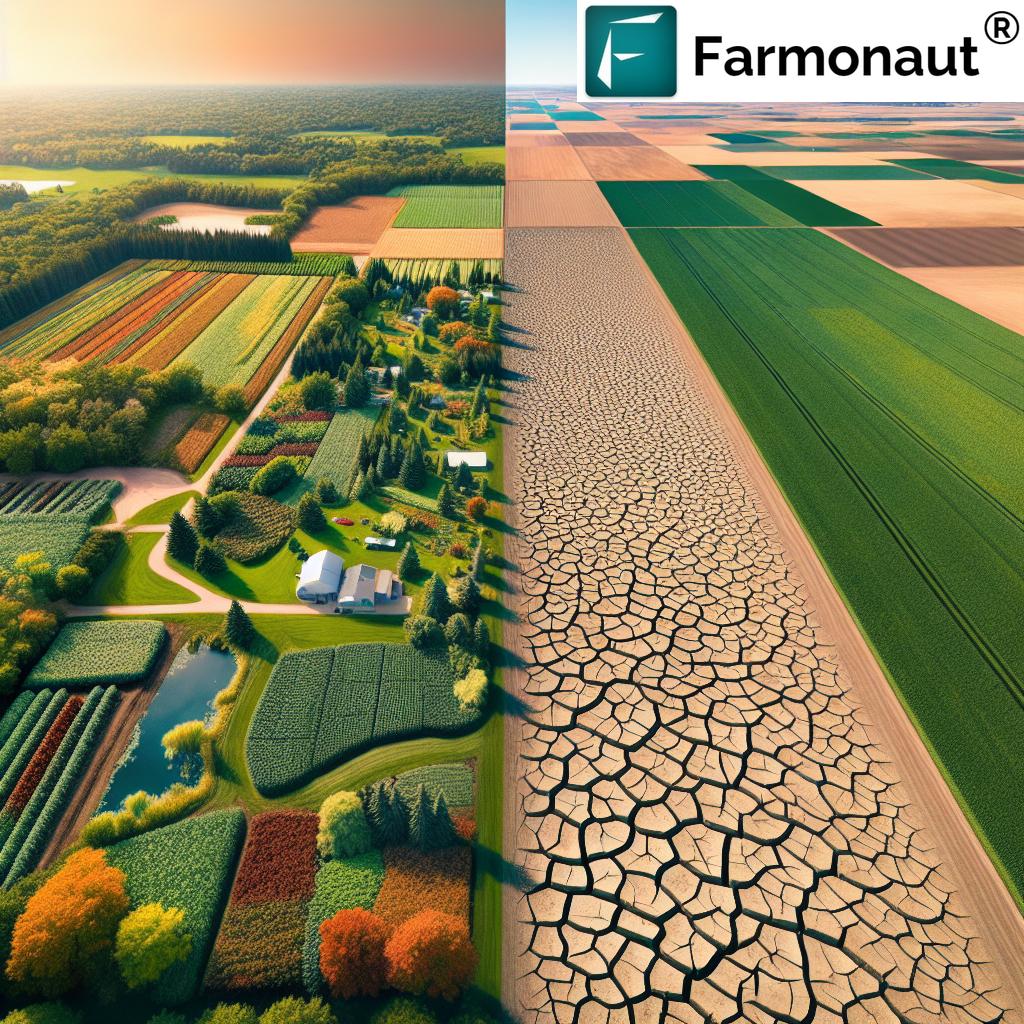Canadian Forestry Industry: Sustainable Practices & Jobs
“Canada’s forestry sector supports over 200,000 jobs, with sustainable practices covering 90% of managed forests.”
Table of Contents
- Summary: The Canadian Forestry Industry in 2025
- Current State of the Canadian Forestry Industry
- Sustainable Forestry Practices in Canada
- Precision Forestry and Technological Advancements
- Indigenous Stewardship and Its Impact
- Jobs in Forestry Industry: Evolving Opportunities
- Comparison Table: Practices, Employment & Environment
- Challenges & Future Outlook for Sustainability
- Forestry Industry in the Digital Era: Farmonaut’s Role
- FAQ: Canadian Forestry Industry & Sustainability
- Conclusion: Shaping the Future of Canadian Forestry
Summary: The Canadian Forestry Industry in 2025
The Canadian forestry industry in 2025 stands as a powerful example of how sustainability and innovation can drive both environmental stewardship and economic resilience. As we navigate the evolving landscape of forestry industry and practices, sustainability has become the guiding principle shaping policies, technologies, and career opportunities within this vital sector.
With nearly 347 million hectares of forest covering almost 40% of Canada’s land base, the industry’s commitment to sustainable practices ensures continued contributions to the economy, cultural heritage, and biodiversity. By embracing advanced monitoring technologies, collaborating with Indigenous communities, and expanding green job opportunities, Canada continues to lead globally in sustainable forestry management while also balancing socio-economic growth and environmental conservation.
Current State of the Canadian Forestry Industry
The forestry sector has been a cornerstone of the Canadian economy and heritage for centuries. Today, it continues as a vital industry, supplying raw materials for industries ranging from paper production to wood construction, and fueling innovation through sustainable practices.
- Forest Area: Canada is home to the third-largest forest area globally, covering approximately 347 million hectares and nearly 40% of the country’s land base.
- Economic Impact: The forestry industry contributes over $24 billion annually to the national GDP.
- Employment: The sector supports approximately 210,000 jobs (direct and indirect), with a significant proportion in rural and Indigenous communities.
- Environmental Role: Canadian forests are critical for global biodiversity, water regulation, and carbon sequestration.
The current state of the canadian forestry industry reinforces its dual role as an economic engine and ecological steward, managing resources responsibly while adapting to technological advancements and environmental challenges.
BC Wildfire Risk 2025 ? 9 Kootenay Projects, Fuel Breaks & AI Satellite Forestry Solutions
Sustainable Forestry Practices in Canada
In 2025, sustainable practices in forestry are more than just buzzwords—they are regulatory, ethical, and operational imperatives that define success in the industry. Canadian forestry practices are widely adopted under frameworks like:
- Sustainable Forest Management (SFM) Principles: These ensure forest health, biodiversity preservation, and water quality protection.
- Certification Programs: Most managed forests are certified by independent organizations such as the Forest Stewardship Council (FSC) and the Sustainable Forestry Initiative (SFI), aligning with global stewardship standards.
- Reforestation: Timber harvesting is offset by comprehensive replanting and natural regeneration strategies to ensure ecosystem balance.
Beyond policy, these practices are actively enforced by regulatory frameworks, promoting continuous innovation and accountability in operations. More than 90% of managed forests in Canada now operate under recognized sustainability certifications.
“Canada leads globally, certifying 36% of the world’s sustainably managed forests for environmental stewardship.”
Canada Fertilizer Boom 2025 | Green Ammonia, AI Precision & $2.3 B Granular Surge
Key Methods in Sustainable Forestry Practices
- Selective Logging: Targeting mature trees while preserving saplings and understory vegetation for biodiversity.
- Controlled Burns: Using prescribed fire to mimic natural cycles, promote regeneration, and reduce wildfire risk.
- Agroforestry & Mixed Plantations: Integrating forestry and agriculture to optimize land use and ecosystem services.
- Continuous Monitoring: Utilizing satellite imaging and other technologies to ensure compliance with sustainable standards.
By adopting these techniques, the canadian forestry industry continuously maintains ecosystem balance, upholds industry reputation, and opens opportunities for new jobs in sustainability oversight, technology operations, and forest management.
Canada Farm-Plastic Record 2025 | 2.2 M kg Recycled, Circular Economy & AI Precision Ag
Precision Forestry and Technological Advancements
Technology drives the evolution of forestry practices towards more accurate, sustainable, and economically sound operations. The Canadian forestry industry is rapidly embracing technological advancements such as:
- Satellite Imaging & Remote Sensing: Farmonaut’s satellite-driven solutions provide high-resolution images to monitor forest health, predict risks, and support resource management.
- LiDAR (Light Detection and Ranging): Used for detailed elevation mapping, timber volume assessment, and canopy structure analysis.
- GIS (Geographic Information Systems): Enables precise mapping and data layering for regeneration success and harvest planning.
- AI-Driven Advisory Systems: Platforms using AI help interpret satellite data for forest management and conservation decisions.
Satellite & AI Based Automated Tree Detection For Precise Counting and Location Mapping
These innovations facilitate informed decision-making on harvest cycles, reforestation efforts, and ecosystem health—minimizing environmental impacts while maximizing resource yield and supporting growing demand for sustainably sourced wood.
Download the Farmonaut app for real-time forest monitoring and sustainability analytics—ideal for land managers, environmental consultants, and forestry businesses seeking actionable, satellite-based insights.
Integrate Farmonaut’s API (API Link) and check developer documentation (API Docs) to automate forest health assessment, precision mapping, and sustainability reporting at scale for forestry organizations.
Looking for end-to-end forest resource management? Explore Fleet Management for optimized vehicle and equipment logistics, and Carbon Footprinting to monitor your operation’s carbon emissions and sustainability footprint.
How Technology Is Advancing Sustainable Forestry
- Precision Mapping: Pinpoints forest composition, health, and regeneration status, helping minimize impacts on sensitive zones.
- Harvest Optimization: Data-driven cycles increase yield per hectare while ensuring ecosystem health.
- Resource Traceability: Platforms like Product Traceability use blockchain to provide supply chain transparency and sustainability assurance.
- Risk Management: Early detection of disease, pests, and fire for proactive response—guarding both jobs and environmental assets.
From Land Use to Space Age Farming: How Farmonaut is Revolutionizing Agriculture with Satellites
Indigenous Stewardship and Its Impact on Canadian Forestry
Canadian Indigenous communities have long been custodians of the nation’s vast forest ecosystems, and their leadership is increasingly recognized in stewardship and management frameworks. The incorporation of Indigenous Knowledge (IK) into mainstream forestry is reshaping:
- Ecosystem Management: Indigenous insights inform restoration and harvesting cycles, maintaining cultural heritage and biodiversity.
- Co-management Agreements: These formal partnerships create career opportunities and shared decision-making roles for Indigenous workers.
- Sustainable Job Creation: Forestry employment now includes roles such as community liaisons, ecological monitors, and policy advisers, many of which are tailored to Indigenous knowledge and stewardship.
- Ethical Resource Use: Emphasizing respect for forests as living entities rather than purely economic assets, ensuring the sustainability of both resources and traditions.
More than a third of new forestry projects in 2025 include Indigenous participation at the planning and execution stages, strengthening Canada’s environmental and cultural leadership on the world stage.
Jobs in Forestry Industry: Evolving Opportunities in 2025
The evolution of sustainable practices in forestry directly correlates with the emergence of new jobs and career pathways in the canadian forestry industry—from rural technicians to digital analysts. Here’s a closer look at the expanding employment landscape:
Traditional and Modern Career Paths
- Forest Technicians & Harvest Operators: Continue to form the backbone of field operations, now with added training in sustainability compliance and data tools.
- Environmental Consultants & Policy Advisors: High demand for expertise in regulatory navigation, sustainability auditing, and community engagement.
- Remote Sensing & GIS Specialists: Mapping, modeling, and data analysis are rapidly growing fields as satellite technology becomes integral to forestry management.
- Forest Ecologists & Conservation Scientists: Work on reforestation, biodiversity monitoring, and climate change adaptation strategies.
- Indigenous Liaison Officers: Strengthening ties between forest companies, local communities, and government for collaborative management.
How Technology is Creating Sustainable Forestry Jobs
- Digital Skills: The use of platforms like Farmonaut demands technical know-how for leveraging real-time monitoring, AI-based advisory, and resource optimization in day-to-day operations.
- Satellite Data Analysis: Interpreting high-resolution imaging for forest health, planning, and impact evaluation (carbon monitoring careers).
- Supply Chain Transparency: Ensuring product integrity with blockchain traceability tools (traceability jobs).
- Fleet and Resource Management: Overseeing logistics and sustainability optimization for large-scale operations (fleet management roles).
By 2025, over 35% of all jobs in the Canadian forestry industry require digital and remote sensing expertise.
Farmonaut Large Scale Field Mapping & Satellite Based Farm Monitoring | How To Get Started
Education, Training, and Skill Development
- Post-secondary Programs: Emphasis is on sustainable forest management, environmental science, Indigenous governance, and digital technology.
- On-the-job Training: Many provinces and forestry companies offer in-house upskilling, particularly in AI and GIS mapping.
- Industry Credentials: Achieving FSC or SFI accreditation opens advanced career and consulting paths.
Community & Economic Opportunities
- Rural and Indigenous Communities: Sustainable forestry jobs combat outmigration and support local economies through stable, long-term employment.
- Emerging Sectors: Growth in bioenergy, wood engineering, and ecosystem services drives new job creation and business opportunities.
Comparison Table of Sustainable Forestry Practices and Their Impact on Employment & Environment in Canada
| Forestry Practice | Estimated Carbon Sequestration (tons/ha/year) | Estimated Biodiversity Index Improvement (%) | Estimated Jobs Created (per region/sector) | Notable Regions of Implementation |
|---|---|---|---|---|
| Selective Logging | 2.1 – 3.5 | 12% | 700–1,100 | British Columbia, Quebec, Ontario |
| Comprehensive Reforestation | 3.8 – 5.2 | 18% | 900–1,500 | Atlantic Canada, Alberta, Manitoba |
| Controlled Burns | 2.0 – 3.0 | 15% | 400–650 | Western Canada, Saskatchewan |
| Forest Certification Programs (FSC/SFI) | 2.5 – 4.0 | 22% | 1,200–2,100 | Country-wide |
| Agroforestry Integration | 4.6 – 5.9 | 20% | 500–900 | Ontario, Prairies |
Note: Metrics presented are approximate and based on 2025 research averages for Canadian provinces.
The table highlights that sustainable forestry practices significantly enhance carbon sequestration, improve biodiversity, and directly create jobs, especially in regions with active certification and comprehensive reforestation strategies.
Challenges & Future Outlook for Sustainability in 2025 and Beyond
Despite the growing adoption of sustainable forestry practices, the Canadian forestry industry continues to face significant challenges, including:
- Climate Change: Increased risks from wildfires, pest outbreaks, and unseasonal weather threaten forest health and regeneration.
- Economic Pressures: Global competition and market fluctuations impact profitability, affecting small producers and investments in innovation.
- Regulatory Uncertainty: Ongoing changes in environmental law require agile adaptation and legal compliance.
- Social License: Communities increasingly demand proof of environmental stewardship and transparent resource management.
Emerging Opportunities Shaping the Future
- Bioenergy & Engineered Wood: Sustainable wood is a cornerstone of the green economy, used in construction, energy generation, and advanced materials.
- Digital and Data-Driven Management: The rise of satellite monitoring and AI-enabled advisories (like those from Farmonaut) facilitate evidence-based management and resilience.
- Green Financing: Satellite-based verification from providers like Farmonaut Crop Loan & Insurance Product enhances access to financing for forestry projects, linking sustainability directly to creditworthiness.
- Policy Support & Community Engagement: Expanding training and incentives encourage workforce development in sustainability, indigenous leadership, and digital forestry skills.
Farmonaut Large Scale Farm Mapping And Satellite Based Farm Monitoring
The future outlook is one of continual adaptation and opportunity—where Canada, leveraging innovation, regulation, and workforce development, continues to lead as a responsible steward of its forest resources.
Forestry Industry in the Digital Era: Farmonaut’s Role in Sustainable Forestry Practices
As digital transformation accelerates, satellite technology companies such as Farmonaut are playing a pivotal role in supporting the canadian forestry industry across multiple dimensions, including environmental, operational, and economic sustainability.
- Satellite-Based Resource Monitoring: We at Farmonaut offer precise, up-to-date forest health status, empowering companies and governments to make evidence-based management decisions across millions of hectares.
- Environmental Impact & Carbon Footprinting: Our carbon footprinting tools (Carbon Footprinting) help forestry organizations track and reduce greenhouse gas emissions, complying with global climate commitments.
- AI-Driven Advisory & Traceability: We utilize AI-based advisory systems for tailored sustainable action plans and blockchain traceability solutions for transparent supply chains, strengthening trust with stakeholders.
- Fleet and Resource Optimization: With our fleet management solutions, companies manage and coordinate vehicles and machinery for efficient, sustainable forest operations.
- Environmental Compliance & Policy: Our platform supports regulatory reporting with objective, third-party data—adding transparency for regulators, investors, and communities.
- Scalable, Affordable Access: Farmonaut lowers cost barriers, enabling small businesses, individual landholders, and major corporations to adopt precision forestry and monitor progress efficiently.
Farmonaut® | Making Farming Better With Satellite Data
From Land Use to Space Age Farming: How Farmonaut is Revolutionizing Agriculture with Satellites
Farmonaut Large Scale Farm Mapping And Satellite Based Farm Monitoring
For forestry professionals seeking an all-in-one advisory suite, our Crop Plantation and Forest Advisory Platform provides AI-driven guidance and real-time satellite updates tailored to Canadian forests’ unique challenges and opportunities.
FAQ: Canadian Forestry Industry & Sustainability
1. What are the most widely adopted sustainable forestry practices in Canada?
Sustainable practices include selective logging, comprehensive reforestation, controlled burns, and management under certification frameworks like FSC and SFI. Most managed forests use a combination of these to ensure ecosystem health and long-term productivity.
2. How does the forestry sector support jobs and communities?
The sector supports approximately 210,000 jobs (as of 2025), with many in rural and Indigenous communities. These range from technicians to digital analysts and policy advisors. Career opportunities are expanding, particularly in digital roles grounded in sustainable practices in forestry.
3. What role does satellite technology play in forestry management?
Satellite technology is central to modern forestry management. It enables real-time monitoring of forest health, supports precision mapping for harvesting and replanting, aids in environmental compliance, and helps forecast risks like fire and disease.
4. Why is Indigenous stewardship important for the Canadian forestry industry?
Indigenous stewardship brings generations of ecological knowledge and contributes to ethical, sustainable forest management that honors both cultural heritage and modern conservation needs. Indigenous involvement leads to more resilient ecosystems and stronger community partnerships.
5. How can forestry companies and managers access affordable satellite-based sustainability solutions?
Companies can sign up for affordable, scalable Farmonaut subscriptions for real-time forest health monitoring, carbon emissions tracking, resource traceability, and more. Farmonaut offers web and mobile apps as well as APIs for seamless operations and compliance.
Conclusion: Shaping the Future of Canadian Forestry
The canadian forestry industry in 2025 represents a beacon of responsible resource management, evolving in harmony with sustainability, technological innovation, and social responsibility. By embedding sustainable forestry practices across all levels—from local management to global certification—Canada ensures its forests remain vibrant contributors to the economy, culture, and environment.
With the embrace of digital solutions, enhanced by platforms such as Farmonaut, and with a deep commitment to Indigenous stewardship and community empowerment, the forestry sector is not only adapting to current challenges but also unlocking a wealth of opportunities for job creation, ecological restoration, and long-term resilience.
Ultimately, sustainable practices in forestry safeguard Canadian forests so they continue to support biodiversity, provide stable employment, and nurture the country’s economic and cultural future—ensuring that Canada remains a global leader in responsible resource management for generations to come.












